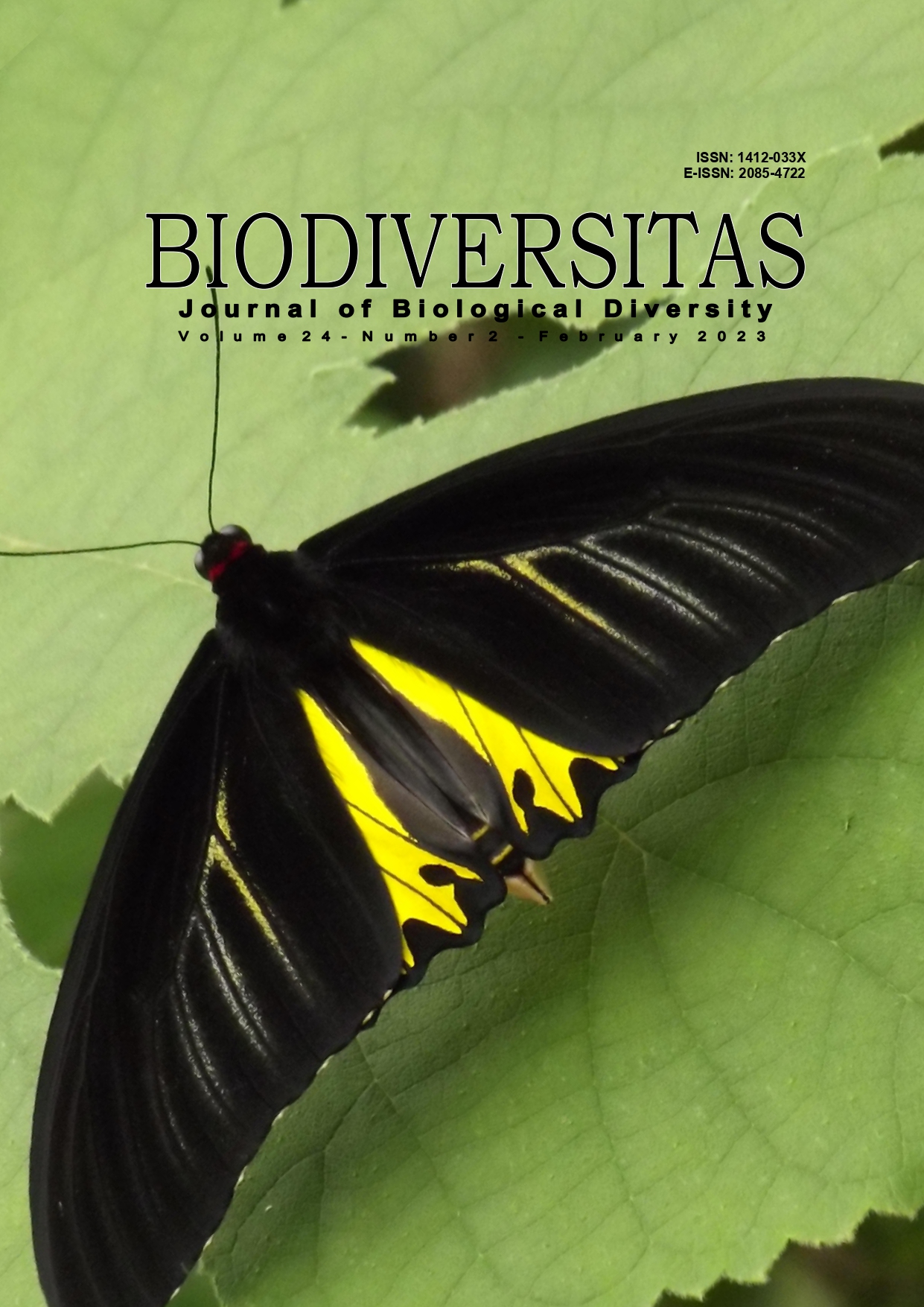Incidence of Escherichia coli producing Extended-spectrum beta-lactamase in wastewater of dairy farms in East Java, Indonesia
##plugins.themes.bootstrap3.article.main##
Abstract
Abstract. Dameanti FNAP, Yanestria SM, Widodo A, Effendi MH, Plumeriastuti H, Tyasningsih W, Sutrisno R, Akramsyah MA. 2023. Incidence of Escherichia coli producing Extended-spectrum beta-lactamase (ESBL) in wastewater of dairy farms in East Java, Indonesia. Biodiversitas 24: 1143-1150. Poor wastewater treatment on dairy farms can potentially become environmental contaminants (hazardous chemicals, organic matter, and pathogenic bacteria). Bacteria from dairy cattle that have been resistant can be found in wastewater. It can migrate around the farm and cause resistance to environmental microbiota. Over the years, cases of antimicrobial resistance (AMR) in Escherichia coli bacteria are increasing due to the uncontrolled use of antibiotics in dairy farms. The present study aimed to identify the potential occurrence of dairy farm wastewater as a reservoir for Extended-Spectrum Beta-Lactamase (ESBL)-producing E. coli in East Java. The number of research samples used was 342 and came from 6 cities/regencies with the highest dairy cattle population in East Java (Pasuruan District, Malang District, Tulungagung District, Blitar District, Batu City, and Kediri District). The results showed that 69.30% (237/342) of dairy farm wastewater samples were positive for E. coli. The incidence of Escherichia coli AMR was 99.17% (235/237). The resistance conditions to each class of antibiotics were 76.4% ampicillin, 66.2% cefotaxime, 37.6% tetracycline, 15.6% ciprofloxacin, 96.2% streptomycin, 16.5% sulfamethoxazole-trimethoprim, and 84.0% chloramphenicol. The incidence of E. coli MDR was 84.25% (198/235), with the highest incidence (44.44%; 88/198) found in the four groups of antibiotics. The incidence of ESBL-producing E. coli from samples of dairy farm wastewater in East Java through DDST confirmation was 22.80% (78/342), with the highest incidence (20.51%; 16/78) in Pasuruan District and Batu City. In conclusion, dairy farm wastewater could be a reservoir for ESBL-producing E. coli which has the potential to impact human health in East Java Province.
##plugins.themes.bootstrap3.article.details##
Most read articles by the same author(s)
- DIAN AYU PERMATASARI, ADIANA MUTAMSARI WITANINGRUM, FRESHINTA JELLIA WIBISONO, MUSTOFA HELMI EFFENDI, Detection and prevalence of multidrug-resistant Klebsiella pneumoniae strains isolated from poultry farms in Blitar, Indonesia , Biodiversitas Journal of Biological Diversity: Vol. 21 No. 10 (2020)
- MUSTOFA HELMI EFFENDI, WIWIEK TYASNINGSIH, YEMIMA ANGGUN YURIANTI, JOLA RAHMAHANI, NENNY HARIJANI, HANI PLUMERIASTUTI, Presence of multidrug resistance (MDR) and extended-spectrum beta-lactamase (ESBL) of Escherichia coli isolated from cloacal swab of broilers in several wet markets in Surabaya, Indonesia , Biodiversitas Journal of Biological Diversity: Vol. 22 No. 1 (2021)
- SANCAKA CHASYER RAMANDINIANTO, ASWIN RAFIF KHAIRULLAH, MUSTOFA HELMI EFFENDI, MecA gene and methicillin-resistant Staphylococcus aureus (MRSA) isolated from dairy farms in East Java, Indonesia , Biodiversitas Journal of Biological Diversity: Vol. 21 No. 8 (2020)
- RIBBY ANSHARIETA, SANCAKA CHASYER RAMANDINIANTO, MUSTOFA HELMI EFFENDI, HANI PLUMERIASTUTI, Molecular identification of blaCTX-M and blaTEM genes encoding extended-spectrum ß-lactamase (ESBL) producing Escherichia coli isolated from raw cow’s milk in East Java, Indonesia , Biodiversitas Journal of Biological Diversity: Vol. 22 No. 4 (2021)
- FRESHINTA JELLIA WIBISONO, BAMBANG SUMIARTO, TRI UNTARI, MUSTOFA HELMI EFFENDI, DIAN AYU PERMATASARI, ADIANA MUTAMSARI WITANINGRUM, Short Communication: The presence of extended-spectrum beta-lactamase (ESBL) producing Escherichia coli on layer chicken farms in Blitar Area, Indonesia , Biodiversitas Journal of Biological Diversity: Vol. 21 No. 6 (2020)
- ASWIN RAFIF KHAIRULLAH, SRI AGUS SUDJARWO, MUSTOFA HELMI EFFENDI, SANCAKA CASHYER RAMANDINIANTO, MARIA AEGA GELOLODO, AGUS WIDODO, KATTY HENDRIANA PRISCILIA RIWU, DYAH AYU KURNIAWATI, SAIFUR REHMAN, Profile of Multidrug Resistance and Methicillin-Resistant Staphylococcus aureus (MRSA) on dairy cows and risk factors from farmer , Biodiversitas Journal of Biological Diversity: Vol. 23 No. 6 (2022)
- MUSTOFA HELMI EFFENDI, HAYYUN DURROTUL FARIDAH, FRESHINDY MARISSA WIBISONO, FRESHINTA JELLIA WIBISONO, NABILATUN NISA, FATIMAH, EMMANUEL NNABUIKE UGBO, Detection of virulence factor encoding genes on Escherichia coli isolated from broiler chicken in Blitar District, Indonesia , Biodiversitas Journal of Biological Diversity: Vol. 23 No. 7 (2022)
- NI KOMANG APRILINA WIDISUPUTRI, NUNUK DYAH RETNO LASTUTI, ENDANG SUPRIHATI, POEDJI HASTUTIEK, HANI PLUMERIASTUTI, MUFASIRIN, HENI PUSPITASARI, LUCIA TRI SUWANTI, Surface ultrastructure of Blastocystis sp. isolated from cattle , Biodiversitas Journal of Biological Diversity: Vol. 22 No. 3 (2021)

